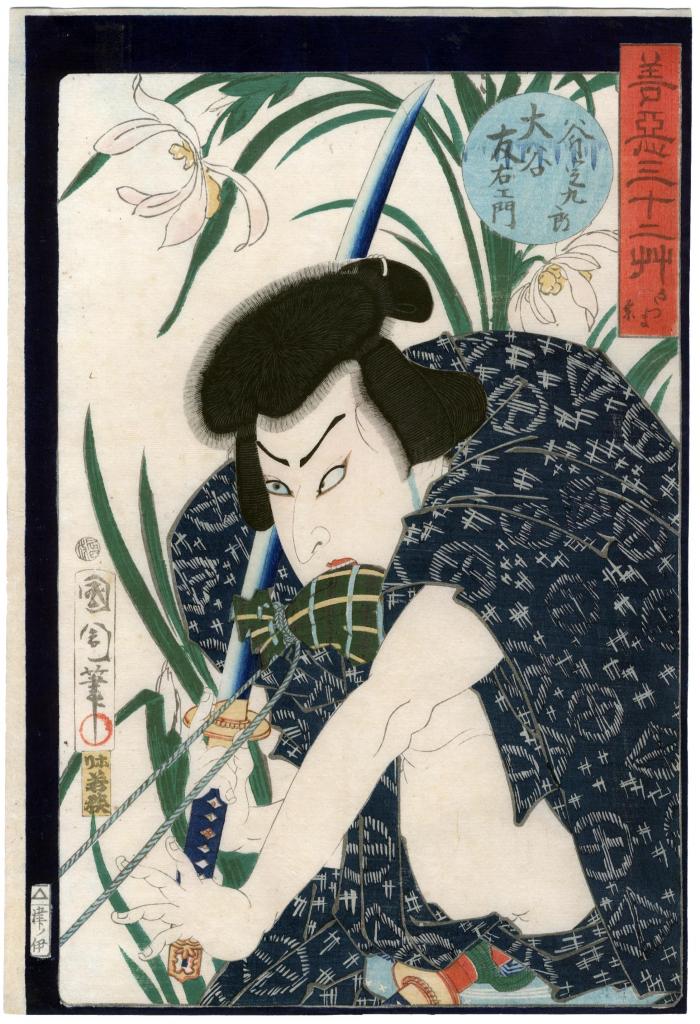Toyohara Kunichika (豊原国周) (artist 1835 – 1900)
Ōtani Tomoemon V (大谷友右衛門) as Ono Sadakurō (斧定九郎) from the series 32 Examples of Good and Evil (Zen-aku sanjunisō - 善悪三十二艸)
04/1868
Signed: Kunichika hitsu (国周筆)
Artist's seal: toshidama
Publisher: Tsunoi (Marks 552 - seal 21-188)
Date seal: 4/1868
Waseda University
Lyon Collection - Hokusai print of Sadakurō murdering Yoichibei Sadakurō and his father Kadayu broke early from the other rōnin who became the famous 47 men bent on revenge for the death of their master.
Ono Sadakurō is a major figure from Act 5 of the Chūshingura. See Lyon Collection print #1402 by Hokusai. In this print he is about to kill the poor farmer Yoichibei who is fallen off to the left of this print. His presence is implied.* We know this, because Sadakurō grips the bag of coins with his teeth, money which Yoichibei has received in exchange for selling his married daughter Okaru to a brothel. Clearly Yoichibei is still clutching at the strings which are used to close or open the purse.
Like we said, Yoichibei's presence is only implied. This is not a diptych, as best we can tell.
[The choice of bold type is our own.]
****
Immediately after this scene Sadakurō is killed accidentally by a shot fired by Kanpei, Okaru's husband. The visual character and nature of Sadakurō is clearly described in The Man Who Saved Kabuki: Faubion Bowers and Theatre Censorship in Occupied Japan by Shirō Okamoto on page 74:
"To take one small example, during Act V of Chūshingura we see the handsome young villain Sadakurō. The scene occurs on a country road in the dark of night, the principal background being an authentic-looking haystack. A moment after Sadakurō emerges from within the haystack, a rifle shot rings out and hits him. Bright red blood spurts from his mouth and he falls in a heap. On the surface, this sounds very realistic, and, in essence, it is. Examining the action more closely, we see that Sadakurō's erotic attractiveness is enhanced by his black kimono, which is raised to reveal startlingly white legs and unshod feet. His face and the rest of his body are also painted dead white, and details of his face are heightened by exquisitely drawn eyebrow, eye, and mouth lines and framed by a glossy black wig with the crown hair grown in. The impression made by his black costume on the night-blackened stage emphasizes the vivid whiteness of his face and limbs. When he is shot, the blood drips out of his mouth in such a way that it splatters on his exposed right thigh, the contrast of red on white being both chilling and beautiful. The manner in which he gropes the air for support before falling in a gracefully twisting movement suggests a moment of choreography sublimated in the depiction of a believably wounded man."
****
Stanleigh Jones noted that the character of Sadakurō in Act V of the Chūshingura as performed in the puppet theater was very small, but that when it was taken over and adapted to kabuki his role was enlarged for dramatic effects.
actor prints (yakusha-e - 役者絵) (genre)
Chūshingura (忠臣蔵 - 47 Rōnin) (genre)
Meiji era (明治時代: 1868-1912) (genre)
Ōtani Tomoemon V (五代目大谷友右衛門: from 1865 to 8/1869 and from 4/1871 until February 1, 1873) (actor)
Tsunokuniya Isaburō (津國屋伊三郎) (publisher)
Hayano Kanpei (早勘平) (role)
